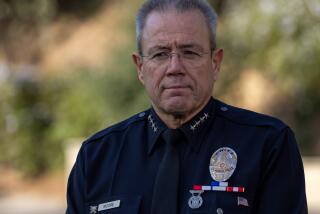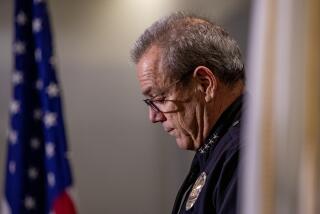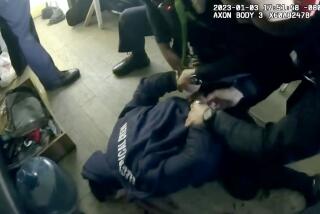Inglewood police have repeatedly resorted to deadly force
One summer evening in 2005, an Inglewood police officer stood with his gun aimed at a schizophrenic man who had been stopped for drinking beer in public.
The officer ordered Jule Dexter to put his hands on the hood of the police car, but Dexter’s baggy pants started slipping.
“Please let me pull my pants up,” Dexter pleaded, according to a witness’ sworn testimony.
“Don’t move!” the officer yelled.
But Dexter, 27, reached to pull up his pants, witnesses said. The officer fired four shots into Dexter’s back and head, killing him.
Over the last six years, Inglewood police officers have repeatedly resorted to physical or deadly force against suspects who were unarmed or accused of minor offenses, a Times investigation found.
In the span of four months this year, Inglewood officers shot and killed four people, three of them unarmed. The Times’ review of court documents, law enforcement records and interviews shows that the problem is not new.
* Five of the 11 people shot and killed by Inglewood police since 2003 were unarmed. They include a man who fled when officers tried to stop him for riding his bicycle on a sidewalk. An officer said he fired when the man reached for a bulge near his waist, which turned out to be a rolled-up T-shirt.
* Several officers -- including a training sergeant -- have complained about the department’s policy on when to shoot and about a lack of training.
* To investigate shootings by police, the department has assigned the vice president of the Inglewood police officers’ union, which advocates for officers accused of wrongdoing, and a detective accused by a prosecutor of lying about his own off-duty shooting.
* Two Inglewood officers were involved in using electric Taser guns on unarmed suspects four times in five weeks -- including on one man’s genitals -- prompting defense attorneys to call them the “Taser Twins.”
Earlier this year, the city hired consultants to review the department’s training, policies and procedures and initiated a training program to improve officers’ tactics.
Inglewood Police Chief Jacqueline Seabrooks said it was unfair to portray her officers as quick to pull the trigger or excessive in using force.
In some cases, she said, police opened fire only after suspects stabbed officers, shot at them or pointed guns in their direction. The 195-member department responds to more than 130,000 calls each year, she said, usually without problems or headlines.
“We interact with people who are exceedingly violent and resistive to the lesser levels of force, and we don’t always shoot them,” said Seabrooks, who became chief last year.
Inglewood officers have shot unarmed people they mistakenly believed posed a threat on six occasions, or a quarter of all shootings by police since 2003. Two of those people were carrying toy weapons. Five died and one was wounded.
On four other occasions, officers opened fire at moving cars, a practice strongly discouraged by many police agencies, including Inglewood.
“That’s a lot of shootings in a smaller department,” said Geoffrey Alpert, a professor at the University of South Carolina who has helped police agencies draft policies on the use of deadly force. “It raises a red flag.”
Comparing officer shootings at different agencies is difficult because of varying crime rates, demographics and force size. Few agencies keep readily available data on the circumstances surrounding such shootings. Nevertheless, statistics from nearby agencies suggest that Inglewood’s numbers are high.
Officers in the neighboring city of Hawthorne, for example, have shot and killed one unarmed suspect since 2003. Hawthorne, which has a crime rate similar to Inglewood’s, has half as many police officers and four-fifths the population of Inglewood.
A report by the Los Angeles County Sheriff’s Department -- which patrols an area with a population more than 20 times larger than Inglewood’s -- shows that deputies have killed fewer unarmed people than have Inglewood police since 2005.
‘He was real gentle, real kind’
Jule Dexter battled his share of problems. He struggled with a drug addiction, and in 2004 his mother sought a restraining order against him, accusing him of pushing her and stealing from her garage.
But when sober, Dexter was a joy to be around, said his aunt Patricia Hayes. “He was a big kid, but he was real gentle, real kind,” she said.
A month before his death, Hayes said, Dexter completed a drug rehabilitation program and told her he was determined to provide for his 3-year-old son, whose name was tattooed on Dexter’s right arm.
But by the night of June 6, 2005, Dexter was using cocaine once again, according to toxicology tests by coroner’s officials.
Just after 6 p.m. he was standing outside an Inglewood liquor store with some friends when an unmarked police car pulled up. Officer Jose Estrada and Det. Louie Johnson of the city’s gang detail approached Dexter’s group.
What happened next is in dispute. Estrada told investigators that Dexter was slow to take his hands out of his pockets and seemed to fumble with what Estrada feared was a weapon.
But witnesses told authorities that Dexter moved his hand to pull up his pants. In a wrongful-death lawsuit brought by Dexter’s family, Earnestine Baldwin, a bystander, testified that she heard Dexter repeatedly beg the officer to let him pull up his pants.
The city paid $725,000 to settle the lawsuit.
“I realize they can be afraid. But they’re supposed to be the skilled ones,” said Hayes, a bank vice president. “What gave them the right to kill my nephew? Where is the justice?”
The district attorney’s office decided not to file criminal charges against Estrada, concluding that he reasonably believed that Dexter was preparing to pull a gun and shoot him.
A panel of three Inglewood police captains decided 2 to 1 that Estrada had not violated the department’s deadly-force policies. But then-Chief Julius I. Davis disagreed and suspended Estrada for 16 days.
Estrada appealed, complaining that he was not trained properly. He has asked a Los Angeles court to throw out the department’s deadly-force policy because it is confusing.
Kenton Ferrin, then Estrada’s training sergeant, testified during Estrada’s disciplinary appeal that the policy is confusing to officers.
The department never ordered additional training for Estrada after the shooting, according to legal documents filed by his attorney.
Seabrooks said she believed the policy was clear, but added that it was being updated to make it more precise.
Investigating their own officers
Like many police agencies, Inglewood entrusts the job of investigating officer-involved shootings to its own homicide detectives. Their work is reviewed by the district attorney’s office.
In recent years, the detectives assigned to such shootings have included Loyd Waters, vice president and former president of the Inglewood Police Assn.
Seabrooks, a former Santa Monica police captain, said she saw nothing wrong with a union official investigating officer-involved shootings, saying it is not unusual in smaller police departments.
But Bill Geller, an Illinois-based public safety consultant and nationally recognized expert in police shootings, described it as a conflict of interest. Police union officials, he said, advocate for their members, but investigators must objectively review the facts of a shooting even if an officer is at fault.
“That seems to me really foolish,” Geller said. “The department is needlessly risking its reputation for integrity and objectivity by doing this.”
Another detective assigned to probe recent officer-involved shootings is Willard Salmon Jr., a 12-year department veteran.
In 2002, Los Angeles police were called to the parking lot of Dodger Stadium after Salmon, while off duty, shot and wounded a paroled carjacker after a game. Salmon told police that he fired in self-defense after the man attacked him with a beer bottle.
But Deputy Dist. Atty. Max Huntsman concluded that Salmon’s account was “not credible.” Two groups of independent witnesses, he wrote in a memo, told police that Salmon wasn’t attacked and that he and his girlfriend hunted for the shell casing and removed it before Los Angeles Police Department officers arrived.
“This behavior supports the conclusion that Salmon felt he had acted improperly and removed the evidence in the brief hope that he might be able to keep himself from being identified,” Huntsman wrote.
The prosecutor also faulted the Inglewood police internal affairs investigators for failing to give Salmon an alcohol breath test until eight hours after the shooting.
Huntsman opted not to file charges against Salmon, deciding that a jury would not be likely to convict him given his claim of self-defense.
Seabrooks said the department’s internal investigation cleared Salmon of wrongdoing and that the agency has received no complaints about his work as a detective.
Salmon said he was assigned to the homicide unit about 18 months ago.
“I don’t think, if they had issues with the shooting or questions about the shooting, they would have put me in the position to investigate officer-involved shootings,” Salmon said in a brief interview.
Last year Salmon was the lead detective investigating the police shooting of an unarmed man, Richard Ray Tyson, according to coroner’s records.
Tyson, 20, was riding his bicycle on the sidewalk when two officers recognized him as an alleged gang member and tried to stop him. Tyson fled, leading the officers on a foot chase until he was cornered in a residential backyard.
Officer Zerai Massey told investigators that Tyson ignored orders to show his hands and moved them toward his waistband. Massey fired six rounds, hitting Tyson’s back and torso. The officer told investigators that he believed Tyson was armed with a gun. No weapon was found on Tyson. Instead, officers discovered a rolled-up T-shirt stuffed in his sweatshirt’s front pocket.
The district attorney’s office found that the officer had acted “in lawful self-defense.” Tyson’s family has filed a wrongful-death lawsuit against the city, alleging that the shooting was unjustified and the investigation inadequate.
As fallout faded, more use of force
In 2002, Inglewood found itself in the national spotlight when a white officer was caught on videotape punching a black teenager and slamming him onto the trunk of a police car. The city installed video cameras in patrol cars, required sensitivity training for officers and set up a panel of citizens to review complaints against the police.
But as the fallout from that episode faded, Inglewood officers have continued to resort to force, including Tasers, on unarmed or handcuffed suspects.
The city settled two lawsuits this year with residents who claimed officers shocked them with Tasers as a punishment rather than to subdue them.
One woman alleged that officers shot her with a Taser twice after she kicked out a patrol car’s rear window while handcuffed and hyperventilating in the back seat. After shocking her, she claimed, the officers asked, “Did you like that?” She collected $95,000. A man who claimed a sergeant stunned him with a Taser at the police station and said it was for biting an officer was paid $55,000.
“It seems there is very little discipline there,” said his attorney, Gary Casselman.
Just how often Inglewood officers deploy their Tasers is unknown. A police spokesman said the department does not keep track of Taser incidents.
But in 2005, deputy public defenders noticed a pattern of complaints by clients who said they were shot with Tasers by Inglewood cops. Two officers stood out.
During one five-week period that year, four people complained that they had been shocked by Officers Eduardo Sanchez and Rafael Rodriguez. Defense attorneys gave them the nickname “Taser Twins.”
“They seemed to be immature and poorly trained officers,” said John Raphling, a former deputy public defender now in private practice. “They seemed to be operating with very little supervision.”
Among those shocked by the pair was Clarence Williams, whom the officers arrested on suspicion of public drunkenness.
At the city jail, Rodriguez and Sanchez, along with a third officer, took Williams to a room to be strip-searched. Sanchez wrote in a report that Williams became belligerent as he got undressed.
Sanchez wrote that Williams, 5 feet 7 and about 160 pounds, took a step toward Rodriguez with his fists clenched. Sanchez said he shot Williams with the Taser, striking him in the genitals and stomach. He said he used the electric current three times before Williams calmed down.
The department’s policy prohibits officers from firing Tasers at a suspect’s genitals.
Williams, 42, told The Times that the officers attacked him without provocation while he was naked and starting to pull his pants up.
Lt. Mike McBride said supervisors concluded that Williams was struck unintentionally in the genitals and that officers otherwise used appropriate force.
He said Sanchez resigned last year during an unrelated internal affairs investigation into alleged misconduct, including making false statements. Rodriguez was fired around the same time. McBride declined to detail why, citing Rodriguez’s pending disciplinary appeal.
The officers could not be reached for comment.
Williams said of the Taser: “It was like pure electricity going through my entire body.” Getting shot in the genitals, he said, caused “excruciating pain.”
More to Read
Start your day right
Sign up for Essential California for news, features and recommendations from the L.A. Times and beyond in your inbox six days a week.
You may occasionally receive promotional content from the Los Angeles Times.








